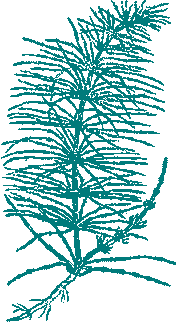
Properties/Actions: Astringent, Anti-inflammatory, Diuretic, Anti-hemorrhage
Phytochemicals Include: 3-methoxy-pyridine, Aconitic-acid, Aluminum, Articulatin, Ascorbic-acid, Beta-carotene, Beta-sitosterol,Caffeic-acid, Calcium, Campesterol, Cholesterol, Chromium, Cobalt, Delta-5,8,11,14-eicosatetraenic-acid, Delta-7,10,13- hexadecatrienic-acid, Delta-8,11,14-eicosatrienic-acid, Delta-9,12,15- octadecatrienic-acid, Dihydrokaempferol, Dihydroquercetin, Dimethyl-sulfone, Equisetine, Equisetonin, Equisetrin, Equisetroside, Ferulic-acid, Fiber, Flavonoids, Gallic-acid, Galuteolin, Gossypitrin, Herbacetrin, Iron, Isofucosterol, Isoquercitrin, Isoquercitroside, Kaempferol, Kaempferol-7-diglucoside, Luteolin, Luteolin-5-glucoside, Magnesium, Malic-acid, Manganese, Naringenin, Niacin, Nicotine, Oxalic-acid, P-coumaric-acid, P-hydroxybenzoic-acid, Palustrine, Palustrinine, Phenolic-acids, Phosphorus, Potasium-chloride, Potassium, Rhodoxanthin, Riboflavin, Selenium, Silica, Silicic-acid, Silicon, Tannic-acid, Thiamin, Thiaminase, Thymine, Tin, Vanillic-acid, Water, Zinc,
| Country | ETHNOBOTANY: WORLDWIDE USES |
|---|---|
| Canada | Sore, Wound |
| China | Anodyne, Carminative |
| Elsewhere | Bladder, Consumption, Diuretic, Dropsy, Dyspepsia , Gout, Gravel, Hemopoietic, Hemostat , Kidney |
| Haiti | Albuminuria, Calculus, Diarrhea, Dropsy, Hematuria, Hemoptysis, Tuberculosis, Albuminuria |
| Iraq | Diabetes, Kidney |
| So America | Antiseptic, Cancer(Bones), Cancer |
| Spain | Tumor, Diuretic |
| Turkey | Antiseptic, Astringent, Carminative, Consumption, Diuretic, Hemostat, Lung, Pile |
6. "Actions: Astringent, stops bleeding, diuretic, anti-inflammatory, tissue healer. Its brittle jointed stems are rich in healing silica, and since the time of the Ancient Greeks, horsetail has been used for wounds. The astringent, healing stems check bleeding in wounds, nosebleeds and heavy menstruation. A strong diuretic for urinary tract and prostrate disorders, they also tonify the urinary mucous membranes, can control bed-wetting, and help with skin problems. The other main use is for deep-seated damage in lung disease."7. "Horsetail is an excellent astringent for the genito-urinary system, reducing hemorrhage, and healing wounds thanks to the high silica content. Whilst it acts as a mild diuretic, its toning and astringent actions make it invaluable in the treatment of incontinence and bed wetting in children. It is considered a specific in cases of inflammation or benign enlargement of the prostrate gland."
14. "Externally, both the American Indians and the Chinese use horsetail to stop bleeding and accelerate the healing of wounds and broken bones. The effectiveness of horsetail in external applications is related to the solubility of silica in the fluids of wounds or in the poultice materials, and its absorption directly into blood and cells at the site of the wound.
Internally, horsetail is often used as a source of minerals, especially silica and calcium, in a form that can be easily used by the body in the production and repair of bone, skin and connective tissue. As a diuretic and astringent it is widely used in the treatment of genitourinary problems such as gravel and inflammations. Europeans, Asians, and Americans use horsetail in the treatment of pulmonary tuberculosis, cystitis, cramps of the bladder, kidney stones, enuresis, lithiasis, dropsy, internal bleeding, fevers, eye disease, nephritis, cystic ulceration, gonorrhea, gout rheumatism, and miscellaneous hemorrhaging conditions of the bladder, kidneys and prostrate. Horsetail has even found its way into folk medicine treatments for cancer.
Research in Europe has shown that horsetail stops bleeding and helps build up the blood. It also possesses good antibiotic action. The use of horsetail to treat atherosclerosis is also currently being validated in European research. Modern research has validated long-standing folk medicine practices of using horsetail to mend connective tissue and bone."
saved from url http://rain-tree.com/horsetail.htm